There is a very wide misconception that ‘lesbian, gay, bisexual and transgender’ (LGBT) constitutes a purely modern phenomenon created by late nineteenth and early twentieth century sexologists and activists. In fact, every pre-modern Asian and Pacific Islander society had what could be termed ‘proto-transgenderal’ and homoerotic traditions which anticipate these contemporary LGBT identities, even if there are significant differences between the pre-modern and the contemporary identity formations.
I would like to suggest that it is important for us as LGBT/queer Asians and Pacific Islanders (API) to address the biggest misconception in API communities — namely, that we are lesbian, gay, bisexual or transgendered because we’ve been hanging around white people too much. The implicit assumption behind that misconception is one of a viral model of gender identity and sexual orientation. The slogan of Queer Nation was “We’re here, we’re queer, get used to it.” When it comes to homosexuality and transgender, the truth is that we have been here — in every Asian or Pacific Island society — since time immemorial.
While it is true that contemporary LGBT identities are of recent vintage, it is equally true that there were people in every pre-modern Asian or Pacific Islander society who were like us in important respects and whom we would call lesbian, gay, bisexual or transgendered.
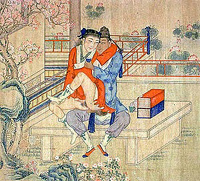
Qing dynasty illustration of male love (18th c.)
China has homoerotic and proto-transgenderal traditions going back centuries. The ‘passion of the cut sleeve‘ (duànxiù 断袖) — the love of the Han dynasty Emperor Ai (27 BC-1 AD) — for his male favorite, Dong Xian — is the source of the Chinese euphemism for homosexuality (‘cut sleeve’). The other popular Chinese euphemism for homosexuality – the ‘half-eaten peach‘ (yútáo 余桃) – goes back even further, to the Zhou dynasty Duke Ling of Wei (衛靈公) (534-403 BC) and his male lover, Mixi Zia(彌子瑕). Ever since Mizi Xia and Dong Xian (董賢), the half-eaten peach and the cut sleeve — yútáo duànxiù (余桃断袖) — have been euphemisms for male homosexuality in China.
There is also the tradition of the Beijing opera dan, as dramatized in Farewell My Concubine, the 1993 film by Chen Kaige starring Leslie Cheung as the male actor and singer who plays women’s roles on stage.
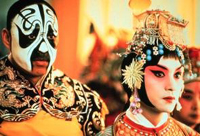
Fengyi Zhang & Leslie Cheung in Farewell My Concubine
There is also a tradition of lesbianism and bisexuality in traditional China, though it is more difficult to find documentation of it than of male homosexuality and bisexuality.
The Golden Orchid Association, for example, was a Chinese women’s organization that celebrated ‘passionate friendships’ and embraced same-sex intimacy. The origins of the Jin Lan Qi (Jinglanhui) have been traced as far back as the Qing dynasty. Members of the group participated in ceremonies of same-sex unions, complete with wedding feasts and exchange of ritual gifts (see Cassell’s Encyclopedia of Queer Myth, Symbol & Spirit, 1997, p. 161). Women of the Golden Orchid Association engaged in sexual practices described as ‘grinding tofu.’
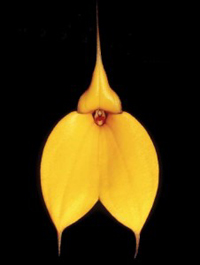
Golden Orchid logo
The ‘Rubbing Mirror Society’ was founded in Guandong province in the seventeenth century by a Buddhist nun and its members participated in same-sex unions (see Cassell’s Encyclopedia of Queer Myth, Symbol & Spirit, 1997, p. 237). Originally known as the ‘Ten Sisters’ by the nineteenth century, the society was called the Mojing Dang.
In the mid-nineteenth century, the philosophy of Chai T’ang (Jaitang) became popular (see Cassell’s Encyclopedia of Queer Myth, Symbol & Spirit, 1997, p. 108). Emerging out of a syncretic Taoist/Buddhist milieu, the philosophy of Chai T’ang found expressing in communal living in ‘vegetarian halls’ or ‘spinsters’ houses’ which emphasized gender equality among members who revered Guanyin (Kwan Yin), a Buddhist bodhisattva of compassion.
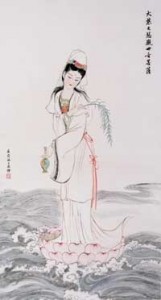
Guanyin, the bodhisattva of compassion
Called the ‘goddess of mercy,’ Guanyin — “She who hears the cries of the world” — is sometimes portrayed as Avalokiteshvara, the male Buddha of the Pure Land who transforms into a female one (Vern L. Bullough, cited in Cassell’s Encyclopedia of Queer Myth, Symbol & Spirit, 1997).
Revered by Chinese Buddhists and Daoists alike, Guanyin has a special place in the hearts of transgendered Chinese and Asians who know of the transgenderal version of the story of the deity of compassion.
In Tibet, the Gelug (or ‘Gelugpa’ – ’Yellow Hat’) strain of Buddhism has long been associated with same-sex relations between monks in its monasteries, especially in the Gelug monastery at Sera (see Cassell’s Encyclopedia of Queer Myth, Symbol & Spirit, 1997, p. 10).
There is a long tradition of homosexuality in Japan, from samurai to Buddhist monks (see Gary Leupp, ”Male Colors: The Construction of Homosexuality in Tokugawa Japan,” University of California, 1997). In fact, Japanese used several terms to refer to male homoeroticism, including nanshoku (male eros), wakashudo (the way of youths), nando (the way of men), bido (the beautiful way) and hido (the secret way).
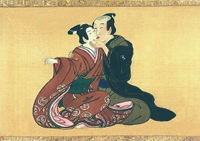
A samurai kisses a kabuki actor in a
shunga hand scroll( Miyagawa Issho, c. 1750).
“The Great Mirror of Male Love” (Nanshoku Okagami), is a collection of 40 homoerotic stories from 1687 by Ihara Saikaku (1642-93) that depicts the nanshoku tradition of male love in all its variety.
And of course, there is the tradition of the onnagata, the male actors who played women’s roles in thekabuki theater — though by no means have all onnagata lived as women or engaged in same-sex relations.
Korea has at least four distinct traditions that anticipate contemporary LGBT identities. First, there is the hwarang warrior elite — sometimes referred to as the ‘flower boys of Silla’ (the dynasty that united the Korean peninsula in the seventh century) — an elite corps of archers who dressed in long flowing gowns and wore make-up. Second, there are the namsadang, the troupes of actors who went from village to village. Among the namsadang, the youths played women’s roles, as in Elizabethan theater. It is said that the youths were often lovers of the older men in the corps.
The homoeroticism of the namsadang tradition was dramatized in “The King and the Clown” (Wang-ui Namja 왕의 남자), a 2005 Korean film by director Lee Jun-ik. The film depicts the relationship between Yeonsangun, a king of the Joseon (Chosun) dynasty who falls in love with a beautifully epicene young actor from a namsadang troupe.
Third, there is the tradition of ‘boy-wives,’ in which youths would wed older men and be recognizes as wives of the men.
And finally, there is the the paksu mudang — the male shaman who performed what was a woman’s role in the ancient shamanic spiritual tradition that Koreans brought into the Korean peninsula from eastern Siberia in pre-historic times.
In South Asia and Southeast Asia, there are many examples of homoerotic and proto-transgenderal traditions, including that of the kathooey (often translated as ‘ladyboys’) of Thailand and the hijra of India, the eunuchs who undergo ritual castration in order to serve as temple priestesses in a tradition that has survived in India to the present day. (See, for example, Michael G. Peletz, ”Transgenderism and Gender Pluralism in Southeast Asia since Early Modern Times,” in Current Anthropology, Volume 47, Number 2, April 2006.)
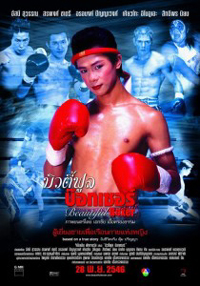
Beautiful Boxer
The 2003 film “Beautiful Boxer” (บิวตี้ฟูล บ๊อกเซอร์) tells the true story of Parinya Charoenphol (‘Nong Toom’), a kathooey who becomes a champion in the sport of Thai kick boxing (muay thai).
The Pacific Islands have many homoerotic and proto-transgenderal traditions, including those of themahu in Hawai’i, the fa’afafine in Samoa (see “The Transgender Taboo“), the fakaleiti in Tonga, thevaka sa lewa lewa in Fiji, the rae rae in Tahiti, the fafafine in Niue, and the akava’ine in the Cook Islands (New Zealand AIDS Foundation, cited in “To Be Who I Am: Kia noho au ki toku ano ao,” a report by the New Zealand Human Rights Commission, 2007, p. 25), and . The Maori of New Zealand have several different terms for those whose gender identity is different from their sex assigned at birth, includingwhakawahine, whakaaehinekiri, tangata ira wahine, hinehi, and hineua (for transgendered women) andtangata ira tane (for trans men) (op cit.).
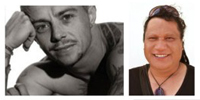
Transman (tangata ira tane) & transwoman (hineua)
(Rebecca Swan photos for the New Zealand Human Rights
Commission report on transgender discrimination, “To Be Who I Am”)
The role of some individuals whom we today would term transgendered as shamanic figures in their cultures’ spiritual traditions is of special significance in discussing proto-transgenderal identities and practices in pre-modern Asian and Pacific Islander societies.
In India, as mentioned before, there is the tradition of the hijra, whose lives are documented in “Harsh Beauty,” a 2005 film by Alessandra Zeka. The hijra undergo ritual castration and devote themselves to the hindu goddess Bahucharamata, living in group houses known as jemadh, as described in Serena Nanda’s classic work, “Neither Man Nor Woman: The Hijras of India” (1990).
As mentioned before, the there is the mudang — the figure who was the priest-like figure in Altaic shamanism. In that culture — the oldest level of Korean society, which predates the introduction of Confucianism, Taoism and Buddhism into the peninula by the Chinese — the mudang was always a woman, but not necessarily female. A significant number of mudang were male, and some of these paksu mudang (male mudang) may have lived as women as well as performing the sacred rites and rituals of themudang spiritual tradition.
Vietnam also has a shamanic tradition, known as dao mau, also presided over by shamans, many of whom are transgendered. The filmmaker Nguyen Trinh documented this tradition in “Love Man Love Woman,” his 2007 documentary about Master Luu Ngoc Duc, one of the most prominent spirit mediums in Hanoi. In the dao mau tradition, it is usually feminine males (referred to as ‘dong co’) such as Master Luu Ngoc Duc who preside over the country’s popular mother goddess religion.
Master Luu Ngoc Duc is but one of many examples of proto-transgenderal shamanic traditions that have survived into the twenty-first century. Another such tradition is that of the bissu, documented in the 2005 film, “The Last Bissu: Sacred Transvestites of South Sulawesi, Indonesia” by Rhoda Grauer.
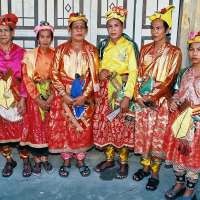
Sulawesi bissu
The Long Island University professor’s documentary focuses on Puang Matoa Saidi, a contemporary bissu priest who is attempting to keep the bissu tradition alive.
In examining the entire history of homoerotic and proto-transgenderal traditions in pre-modern Asian and Pacific Islander societies, we must not make the mistake of romanticizing such traditions or failing to recognize the significant differences between ‘them’ and ‘us’ — meaning contemporary queer LGBT/queer APIs, especially those of us in the diaspora. Those ancient traditions are embedded in societies which were not characterized by equality of age, gender or class relations, and many of the forms that homoeroticism and transgenderal identity took would offend our egalitarian sensibilities.
The important point is that we as LGBT/queer APIs must known the history of our predecessors in order to counter the narrative of LGBT and queer as foreign, white, Western, and even specifically North American; only in doing so can we reinsert ourselves in the governing narratives of our countries, cultures and communities of origin.
Pauline Park is chair of NYAGRA, the New York Association for Gender Rights Advocacy (nyagra.com), a statewide transgender advocacy organization that she co-founded in 1998. She also co-founded Queens Pride House (a center for the LGBT communities of Queens) in 1997 and currently serves as president of the board of directors. Park co-founded Iban/Queer Koreans of New York in 1997 and served as its coordinator from 1997 to 1999. She also serves as vice-president of the board of directors of the Transgender Legal Defense & Education Fund (transgenderlegal.org). Park led the campaign for the transgender rights law enacted by the New York City Council in 2002. In 2005, she became the first openly transgendered grand marshal of the New York City Pride March. She did her B.A. at the University of Wisconsin-Madison, her M.Sc. at the London School of Economics and her Ph.D. at the University of Illinois at Urbana. Park has written widely on LGBT issues and has conducted transgender sensitivity training sessions for a wide range of organizations. She was the subject of “Envisioning Justice: The Journey of a Transgendered Woman,” a 32-minute documentary that premiered in 2008.
This article was first published on paulinepark.com and is republished with permission.
